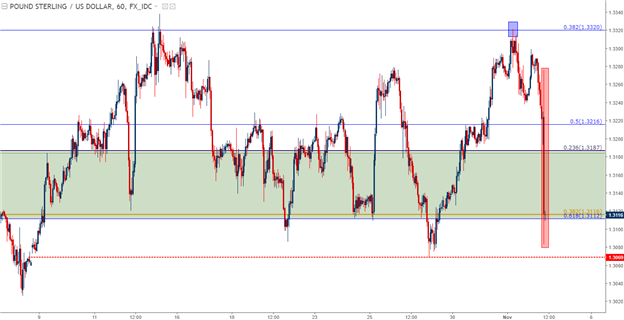At this morning’s Bank of England interest rate decision, the Bank of England hiked rates for the first time in ten years. Rates were adjusted up to .5% from a prior .25%, and while this move of tightening was the first such adjustment in over a decade (the first since Gordon Brown was the Prime Minister), the British Pound sold-off on the news as the Bank of England did not sound too optimistic around future economic conditions.
GBP/USD Hourly: Cable Crumbles to Prior Support as BoE Hikes Rates

Chart prepared by James Stanley
This was a Super Thursday event, which means we also received updated forecasts from the Bank of England, along with an accompanying press conference from BoE Governor, Mr. Mark Carney. It was within those projections that the driver for GBP’s moves seemed to emanate: The BoE is expecting only two more hikes going out to the end of 2020. This would speak to the ‘gradual’ element behind the BoE’s tightening strategy that Mark Carney has been openly talking about. The BoE also said that they remain cautious around Brexit, claiming that negotiations are already bearing a noticeable impact on the economic outlook.
Specifically, the BoE said: “Uncertainties associated with Brexit are weighing on domestic activity, which has slowed even as global growth has risen significantly… And Brexit-related constraints on investment and labour supply appear to be reinforcing the marked slowdown that has been increasingly evident in recent years in the rate at which the economy can grow without generating inflationary pressures.”
This does not sound like a Central Bank that has just hiked rates. This, instead, sounds like a Central Bank waiting for their economy to fall over a cliff, even though inflation just printed above 3% and unemployment remains at 42-year lows. This, combined with the BoE’s rate expectations, indicates that the Bank of England is looking at this hike as a ‘one and done’ type of move, at least for now.












Leave A Comment